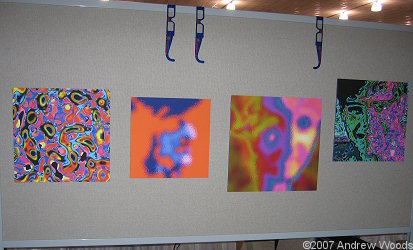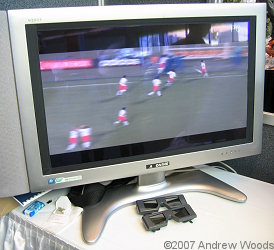


2007 Proceedings





2007 Photos

 




Other Years


















|
|
Photo Album of the
Stereoscopic Displays and Applications XVIII (2007) Conference
The Demonstrations
This year's demonstration session was the biggest yet.

| |
[0] A snapshot of the demonstration session - just look at how full the far aisle is.
This year the following items were on display at the 2007 demonstration session:
 
| |
[1a,1b] Alan Sullivan from Lightspace Technologies (Norwalk, Connecticut) demonstrated the DepthCube 3D volumetric display showing volumetric medical images.
|
 | |
[2] John Rauseo from Polaris Sensor Technologies (Huntsville, Alabama) demonstrated their 10" and 17" stereoscopic flat panel displays based on the variable polarization angle technique and viewed using polarized 3D glasses.
|
 
| |
[3a,3b] John Dammann from the Army Research Laboratory (Adelphi, Maryland) demonstrated a new 3D terrain visualization technique using a LIDAR dataset of Washington DC on a Sharp RD3D autostereoscopic laptop.
|
  
| |
[4a,4b,4c] Avi Yaron and staff from Visionsense (Orangeburg, New York) demonstrated a single miniature stereoscopic sensor suitable for use in endoscopes and other applications. Sample 3D video from the camera was shown on a Planar StereoMirror stereoscopic display.
|

| |
[5a] Nick Holliman and Barbara Froner from Durham University (Durham, United Kingdom) used a Sharp RD3D autostereoscopic laptop to demonstrate task stimulus that was used in their paper to compare the performance of seven different 3D displays. They also demonstrated a high contrast 36 view lenticular image using a new lenticular element from Ocuity.
|
  
| |
[6a,6b,6c] Professor Hideki Kakeya and Hiromitsu Ebisu from University of Tsukuba (Tsukuba, Japan) demonstrated MOEVision: a multiview 3D display with floating real image.
|
  
| |
[7a,7b,7c] Takafumi Koike from Hitachi Ltd (Kawasaki, Japan) demonstrated an integral videography display with an optimized color filter layout. The display was interactively controllable with a game control pad.
|

| |
[8] Ianir Ideses from Tel Aviv University (Tel Aviv, Israel) demonstrated real-time automatic 2D to 3D conversion algorithm on two PC laptops viewed using anaglyph glasses.
|
 
| |
[9a,9b] Aira Hotta from Toshiba Corporation (Kawasaki, Japan) demonstrated the Head Dome Projector - a head-mountable personal projection system in which a 2D image is projected on the inside of a dome-shaped screen with wide viewing angle of about 150 degrees horizontal.
|
 
| |
[10a,10b] John Miller from dep3D (Los Gatos, California) demonstrated a range of stereoscopic PC games and stereoscopic video on their polarized stereoscopic rear-projection display powered by a PC with an NVIDIA graphics card.
|
 
| |
[11a,11b] Kevin Gilson from Parsons Brinkerhoff (Denver, Colorado) showed sample 3D renderings and animations for design visualization viewed using a DepthQ stereoscopic projector.
|
 
| |
[12a,12b] Jason Goodman from 21st Century 3D (New York) demonstrated the 3DVX3.5 High-Definition stereoscopic video camera and showed some sample footage from the camera using a Sharp AL3D autostereoscopic laptop.
|
  
| |
[13a,13b,13c] Mike Weissman and Forrest Fleming from TrueVision Systems (Santa Barbara, California) demonstrated TrueVision, a real-time HD (1280x1024x2 @ 30p) 3D video camera system for stereomicroscopes. Live microstereoscopic video was displayed on a Planar StereoMirror stereoscopic display.
|
 
| |
[14a,14b] Pat Green and Scott Robinson from Planar Systems (Beaverton, Oregon) demonstrated the Planar StereoMirror SD2320W 23" widescreen 1920x1200 stereoscopic monitor. 3D content shown included medical stereoscopic images.
|
 
| |
[15a,15b] Chaio Wang from the University of Southern California (Los Angeles, California) demonstrated stereoscopic panorama creation software on a Sharp AL3D autostereoscopic laptop.
|
 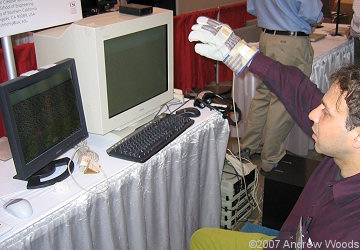
| |
[16a,16b] Shin-Ching Yeh from the University of Southern California (Los Angeles, California) demonstrated a virtual reality clinical experiment on post-stroke rehabilitation using different stereoscopic displays: a Sharp LL-151-3D autostereoscopic monitor, a CRT monitor with LCS 3D glasses, and an eMagin stereoscopic HMD.
|
 
| |
[17a,17b] Graham Woodgate from Ocuity (Oxford, United Kingdom) demonstrated a cell phone handset fitted with an autostereoscopic display using its polarization activated microlens technology. A range of still and moving image 3D content was shown on the phone.
|
 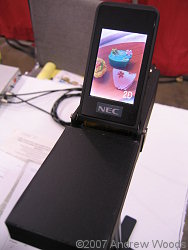 
| |
[18a,18b,18c] Nobauki Takanashi from NEC Corporation (Sagamihara, Japan) demonstrated two cell phone autostereoscopic displays (2.5" diagonal and 320 x 2 (R,L) x 480 x3 (R,G,B) resolution). Content shown included a motion 3D movie and 2D/3D still pictures.
|
   
| |
[19a,19b,19c,19d] Boyd MacNaughton from MacNaughton, Inc. (Beaverton, Oregon) demonstrated the Perceiva 19" 1280x1040 dual LCD stereoscopic monitor based on the variable polarization angle technique and viewed with passive polarized 3D glasses. Also shown were the new NuVision washable active 3D glasses for 3D cinema applications.
|
 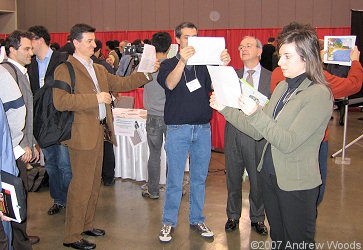 
| |
[20a,20b,20c] Masayuki Iizuka from Tokyo Polytechnic University (Atsugi, Japan) demonstrated the merits and demerits of united, synthesized, and mixed type autostereograms.
|

| |
[21] Benjamin Rose from North Carolina State University (Raleigh, North Carolina) demonstrated stereoscopic renderings of fire on a PC laptop.
|

| |
[22] Kazuhisa Yanaka from Kanagawa Institute of Technology (Atsugi, Japan) showed an autostereoscopic display based on two mutually perpendicular lenticular sheets.
|

| |
[23] Morgan Hurley from Richardson Electronics (El Cajon, California) demonstrated the Philips 20" 20 3D2C03/00 2D/3D switchable 9-view autostereoscopic display.
|
   
| |
[24a,24b,24c,24d] Robert-Paul Berretty and Dick De Boer from Philips (Eindhoven, Netherlands) demonstrated a prototype 42" 2D/3D switchable 9-view autostereoscopic display in which the display could be part 2D and part 3D at the same time.
|
  
| |
[25a,25b,25c] Peter Wimmer from 3DTV.AT (Linz, Austria) demonstrated stereoscopic player (3D video player), stereoscopic multiplexer (3D video recording), and two Sony HDV cameras mounted as a stereo-pair controlled by a LANC camera controller from Digi-dat (Roth, Germany).
|
  
| |
[26a,26b,26c] Raffaello Galli from ANDXOR Corporation (New York) demonstrated a megapixel digital stereo camera on a variable stereo base support controlled by Solid-Look software and displayed on two autostereoscopic displays - a Sharp LL-151-3D and a DTI 19". An integrated, noninvasive eye tracking system allowed hands-free camera movement.
|
  
| |
[27a,27b,27c] Ed Lazarus from Bristlecone Corporation (New York) demonstrated a stereo microscope fitted with two analog cameras attached through Solid-Look software and displayed on a DTI 19" autostereoscopic display. A stereoscopic analog zoom controlled camera was also shown.
|
  
| |
[28a,28b,28c] Julien Flack from Dynamic Digital Depth (Perth, Australia) showed a prototype 3D mobile phone based on Ocuity's polarization activated microlens display technology and running DDD's mobile software solution for stereoscopic video, a 32" Olevia 3D HD TV made by Syntax-Brillian with Arisawa's Xpol technology viewed with polarized 3D glasses, and Google Earth running in stereoscopic 3D using TriDef Visualizer for OpenGL Driver on a Sharp AL3D autostereoscopic laptop.
|

| |
[29] Professor Eun-Soo Kim and colleagues from the 3D Display Research Center (3DRC) at Kwangwoon University (Seoul, South Korea) showed information and videos about a range of 3D display prototypes developed at 3DRC.
|

| |
[30] Joel Kollin from University of Washington (Seattle, Washington) and Ari Hollander from Imprint Interactive Technology (Seattle, Washington) showed a digital stereoscope system based on two LCD panels and mirrors with a VR demonstration application.
|
All photographs © 2007 Andrew Woods, John Merritt, Steven L Smith, John Toeppen, or 3DRC as noted.
Higher resolution images available upon request.
|
|



































































